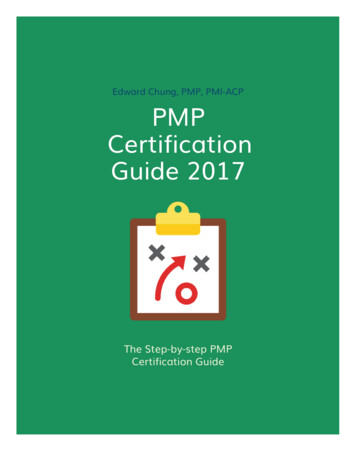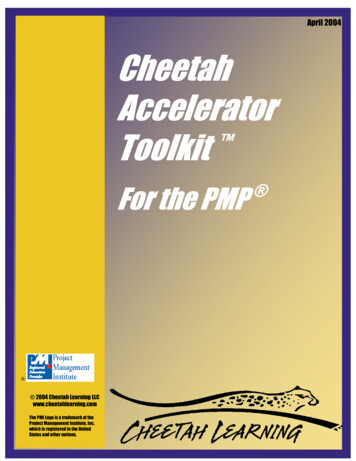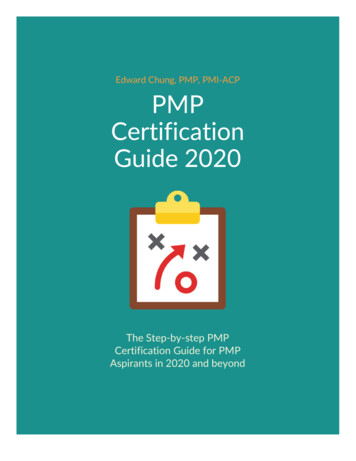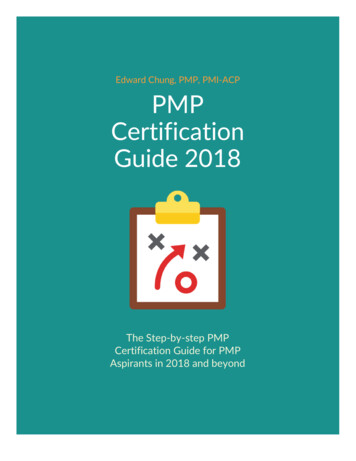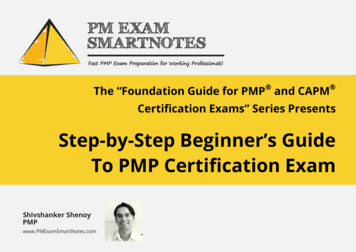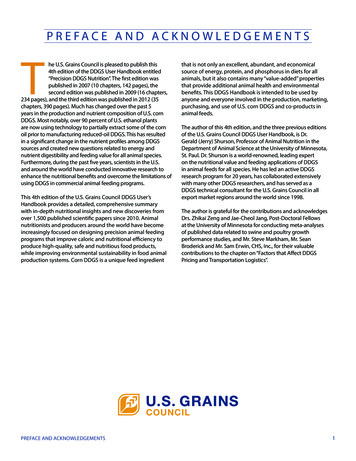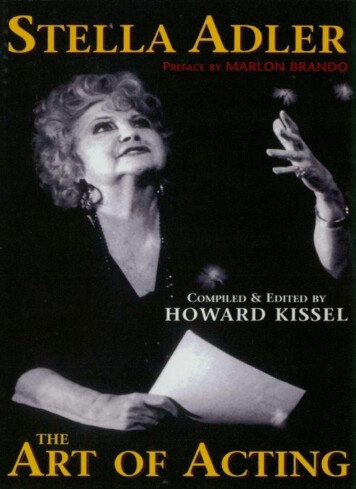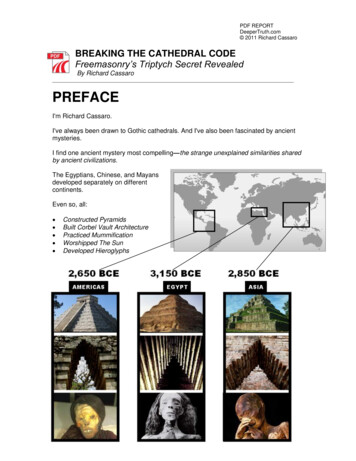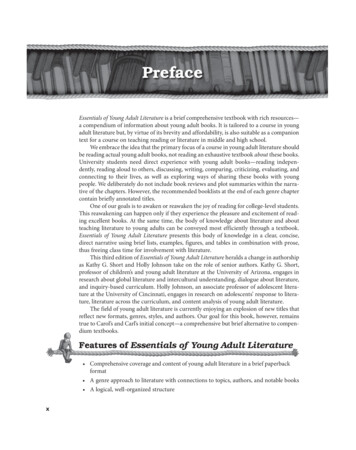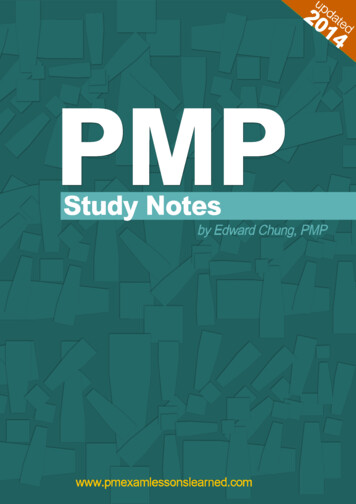
Transcription
PrefaceThank you very much for downloading the PMP Study Notes based on PMBOK Guide 5thEdition by Edward Chung, PMP. Hope the notes will help you preparing for your PMPCertification Exam.I originally created the notes for my PMP certification preparation which helped me to pass thePMP exam with 4 proficient and 1 moderately proficient. These study notes were the fruits ofhours of reading and studying the PMBOK Guide, the PM PrepCast, the Edwel's PMP Book,Andy Crowe's PMP book and countless practice exams.After getting my PMP credential, I posted all the PMP study notes as blog posts on mypersonal blog at http://www.edward-designer.com/web/pmp. To my surprise, many fellow PMPaspirants find my notes useful for them and have literally 'printed' all the blog posts for theirPMP preparation.I constantly ask myself: what I can do more to help PMP aspirants as a way to make somecontribution to the project management profession. The PMP Study Notes you are nowreading is my response to the need of PMP aspirants quality study notes for the PMPexamination. You can use it from the beginning of your PMP preparation so that you can addany personal notes to it or as a last minute revision notes to check your PMP progress.The PMP exam is tough, yet with lots of efforts and the right study materials, you can pass too!Wish you PMP success!Edward Chung, PMPP.S. If you would like to get more tips on the PMP application process and how to know youare ready for the PMP exam, please visit my blog http://www.edward-designer.com/web/pmp.
Table of Contents01. Terms and Concepts02 - 03. Project Management Processes and Knowledge Areas04. Project Integration Management05. Project Scope Management06. Project Time Management07. Project Cost Management08. Project Quality Management09. Project Human Resource Management10. Project Communication Management11. Project Risk Management12. Project Procurement Management13. Project Stakeholder Management14. Professional and Social ResponsibilityA. PMP FormulasB. Last Minutes Revision Notes
01. Terms and ConceptsProcess - a package of inputs, tools and outputs, there are 47 processes defined byPMIPhases - a group of logically related activities, produces one or more deliverables at theend of the phase (maybe with exit gate/kill point [probably in a sequential relationship])Phase-to-Phase relationship: sequential - finish-to-start; overlapping - for schedulecompression (fast tracking); parallelProject - a temporary endeavor to create a unique product, service or result (orenhancement of existing services/products (e.g v.2 development is a project) ) asopposed to operation, may hand over the product to operation teamsOperation manages process in transforming resources into outputprojects have more risks and uncertainties than operations and require more planningProgram - a group of coordinated projects, taking operations into account, maybe withcommon goals, achieving benefits not realized by running projects individually, if onlythe client/technologies/resource are the same, then the projects should be managedindividually instead of a programPortfolio - group of programs/projects to achieve organizational strategic goals withinthe organization/operation management, all investments of the organization, maximizethe value by examining the components of the portfolio and exclude non-optimalcomponentsWhy projects: market demand, organizational need, customer request, technologicaladvance, legal requirements, to support organization strategic plan - projects bringvaluesBusiness Value is the total values (tangible and intangible) of the organizationOrganization Strategy may be expressed through mission and visionUse of portfolio/program/project management to bridge the gap between organizationstrategy and business value realizationProgressive Elaboration (rolling wave planning is one of the methods used inactivity planning) - analysis and estimation can be more accurate and elaborated as theproject goes (usually in phased projects) such that detailed planning can be made atthat pointProject ManagementProject Management - the application of (appropriate) knowledge, skills, tools &techniques to project activities to meet the project requirements and achieve customersatisfactionsThe most important task is to align stakeholder expectations with the projectrequirements, around 90% of the PM's work is related to communication withstakeholdersPMBOK Guide is a framework/standard but not methodology (agile, scrum, PRINCE3,etc.)should be aligned with organization governance (through EEF and OPA)Competing constraints: time, cost, scope, quality, risk, resourcesProject Management Office (PMO) - standardizes governance, provides training,shares tools, templates, resources, etc. across all projects/programs/portfolios3 forms: supportive, controlling and directing (lead the project as PM)functions: training, resource coordination, methodology, document repository, projectmanagement oversight, standards, career management of PMsmay function as a stakeholder / key decision maker (e.g. to terminate the projects)
align portfolios/programs/projects with business objectives and measurement systemscontrol shared resources / interdependence across projects at the enterprise levelplay a decisive role in project governanceOrganizational Project Management (OPM)strategy execution framework utilizing portfolios, programs and projects andorganizational enabling practices (technology, culture, etc.) for achieving organizationalobjectiveslinking management principles with strategy, advance capabilitiesManagement by Objectives (MBO) : is a process of defining objectives within anorganization so that management and employees agree to the objectives andunderstand what they need to do in the organization in order to achieve them.Organizational Project Management Maturity Model (OPM3) : provides a method fororganizations to understand their Organizational Project Management processes andmeasure their capabilities in preparation for improvement.Project ManagerProject Manager: knowledge, performance, personal - general (organization, planning,meeting, control) management, interpersonal (communication, leadership, motivation,influence, negotiation, trust building, political and cultural awareness) skillsleader of the project irrespective of the authorityshould consider every processes to determine if they are needed for individual projectsmay report to the functional manager, program manager, PMO manager, operationmanager, senior management, etc., maybe part-time or devotedidentifies and documents conflicts of project objectives with organization strategy asearly as possibleskills: leadership, team building, motivation, influencing, coaching, trust building,communication, political awareness, cultural awareness, decision making, conflictmanagement, negotiationPM must balance the constraints and tradeoffs, effectively communicate the info(including bad news) to the sponsor for informed decisionsPM need to involve project team members in the planning processProject Team includes PM, project management staff, project staff, PMO, SME (subjectmatter experts can be outsourced), customer representative (with authority), sellers,business partners, etc., maybe virtual or collocatedSenior management must be consulted for changes to high-level constraintsOrganization TypesOrganization Types: Projectized (project manager has the ultimate authority over theproject, team members are often collocated), Matrix (Strong, Balanced, Week),FunctionalComposite - a combination of different types, depending on the actual needTight Matrix co-location, nothing to do with the organization type (not necessarily amatrix org.)Functional organizations the project manager has little authority, often called projectexpeditor (no authority) or coordinator (little authority), project coordination amongfunctional managersMatrix organization multiple bosses and more complexProject Based Organization (PBO) - conduct the majority of their activities as projectsand/or privilege project over functional approaches, they can include: departments withfunctional organizations; matrix organizations; projectized organizations and other formsof organizations that privilege a project approach for conducting their activities, successis measured by final results rather than position/politics
Project Lifecycle vs Project Management Lifecycle vs Product LifecycleProject Lifecycle: initiating, planning and organizing, carrying out/executing work,closing the projectPredictive [plan driven/waterfall] - scope, time and cost determined early in thelifecycle, may also employ rolling wave planningIterative [incremental] - repeat the phases as understanding of the project increasesuntil the exit criteria are met, similar to the rolling wave planning, high-level objectives,either sequential / overlapping phases, scope/time/resources for each phase may bedifferentAdaptive [change driven/agile] - for projects with high levels of change, risk and/oruncertainty, each iterative is very short (2-4 weeks), work is decomposed into productbacklog, each with a production-level product, scrum is one of the most effective agilemethods, stakeholders are involved throughout the process, time and resources arefixed, allow low change cost/keep stakeholder influence higheach project phase within the product lifecycle may include all the five projectmanagement process groupsproduct lifecycle: development production adoption & growth maturity decline end of lifeImportant TermsOrganization Process Assets is a major input in all planning process, which may bekept at PMO, directly related to project management, including Processess andProcedures (including templates (e.g. WBS, schedule network diagrams, etc.),procedures for issuing work authorizations, guidelines, performance measurements)and Corporate Knowledge BaseThe Configuration Management Knowledge Bases contain baselines of allorganization standardsLessons Learned - focus on the deviances from plan (baseline) to actual resultsEnterprise Environment Factors (often are constraints) are influences not in theimmediate control of the project team that affect the project, intra-organization andextra-organization, e.g. organizational culture, organization structure(functional/matrix/projectized structure), existing human resources, work authorizationsystem, PMISThe work authorization system (WAS) is a system used during project integrationmanagement to ensure that work gets done at the right time and in the right sequenceEEF are inputs for all initiating, most planning process, not much in theexecuting/controlling process, none in closing processOrganization culture: process-oriented/results-oriented, ed/parochial-oriented, open system/closed system, tight control/loosecontrol, pragmatic/normativeProject Governance - for the whole project lifecycle, fits in the organization'sgovernance model, define responsibilities and accountabilities, controlling the projectand making decisions for success, alignment of project with stakeholders'needs/objectives, provides a framework for PM and sponsors to make decisions tosatisfy both parties, should be described in the PM planAnalytical Techniques: used to find the root cause or to forecastPMIS includes configuration system and change control systemNever accept a change request to trim down one element of the triple constraint withoutchanging the rest.Sponsor - provides resources/support to project, lead the process through initiation(charter/scope statement) through formally authorized, later involved in authorizing
scope/budget change/reviewCustomer - NOT necessarily provide the financial resources, maybe external to theorganization, final acceptance of the productBusiness Partners - certification body, training, support, etc.Organizational Groups - internal stakeholdersBusiness Case : background, analysis of the business situation, costs and benefits(cost-benefit analysis), to help in selection of project created by the initiatorProject Statement of Work (SOW) : describes the business need, high level scope ofdeliverables and strategic plan of the organization, created by thesponsor/initiator/buyerProject Charter : formally authorizes the project, includes all those from above plusapproval criteria, preliminary budget, primary stakeholders, the name of PM,assumptions and decisions etc., usually created by PM (in develop project charterprocess) and signed by the sponsor, remains fairly the same during project lifecycle,except big changes like sponsor has resigned [the current sponsor should initiate thechange to the charter before he leaves]Project Charter is not a contractProject Management Plan : how the project will be performed and managed documents assumptions & decisions, helps communication between stakeholders,goals, costs & time scheduling (milestones), project management system andsubsidiary management plans and documentsProject Management Plan is NOT a project scheduleProject Management System: includes a list of project management processes, level ofimplementation (what actions to take in the management processes), description oftools and techniques, resources, procedures, change control system [forms withtracking systems, approval levels]Requirement Traceability Matrix (RTM) - a matrix connecting deliverables torequirements and their sources (for managing scope)Work Breakdown Structure (WBS) - a hierarchal chart of decomposing deliverablesinto work packagesActivity List - a full list of all activities with indication of relationship to the workpackagesActivity Attributes - further information (duration, start date, end date, etc.) of all theactivities in the list (for scheduling)Roles and Responsibilities (RAR) - a document listing all the roles and description oftheir responsibilities in the project (often by category)Responsibility Assignment Ma
Edition by Edward Chung, PMP. Hope the notes will help you preparing for your PMP Certification Exam. I originally created the notes for my PMP certification
